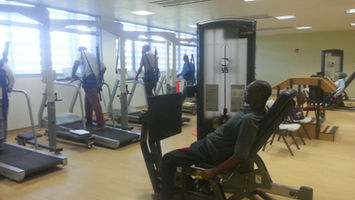JAMMS – Jamaica Muscle and Metabolism Study in Post-Stroke Recovery
Solutions for Medicine
UWI SODECO
2015 - 2019

Project Overview
After a stroke, survivors often experience severe muscle degradation, particularly in the affected limb. This includes muscle atrophy, fat infiltration, inflammation, and metabolic changes that increase the risk of insulin resistance and cardiovascular disease. The JAMMS project investigates whether structured exercise during early stroke recovery can preserve muscle structure, improve glucose metabolism, and enhance overall cardiometabolic health. This is the first study of its kind focused on African-Jamaican adults recovering from ischemic stroke.
Project Details
Key Objectives
Track the natural progression of muscle and metabolic abnormalities in the months following stroke.
Test the effectiveness of early structured exercise, through a novel training program called TEXT—in improving muscle health, fitness, and glucose regulation.
Compare the outcomes of exercise intervention with standard tertiary stroke care to evaluate added health benefits.
Scientific Background
In stroke survivors, particularly in the paretic (P) leg, muscles undergo:
Atrophy and fat infiltration
A shift toward anaerobic, insulin-resistant fiber types
Inflammatory changes (e.g., increased TNF-α) similar to those seen in aging-related muscle loss (sarcopenia)
Current stroke rehabilitation often overlooks muscle integrity and metabolic health as core components of recovery.
Study Design
Population: African-Jamaican adults in the sub-acute phase of ischemic stroke
Intervention: 6-month task-oriented exercise training (TEXT) program vs. best available medical care
Measurements:
Aim 1: Muscle protein synthesis/breakdown, inflammation (TNF-α), thigh muscle volume and strength in paretic and non-paretic limbs
Aim 2: Glucose tolerance, cardiorespiratory fitness, and muscle fiber composition
Hypotheses Being Tested
Exercise will restore muscle health by boosting protein synthesis, reducing inflammation (TNF-α), and increasing muscle volume and strength. Exercise will improve glucose tolerance, enhance fitness levels, and preserve oxidative muscle fiber composition in the affected leg, reducing future cardiometabolic risk.
Conclusion
This study will clarify whether early exercise can act as a muscle-preserving, metabolism-improving therapy for stroke survivors—particularly in underserved populations. If successful, the TEXT program could be scaled to complement stroke rehabilitation services and help reduce long-term disability and chronic disease burden.
Related Documents

FileName.all

FileName.all

FileName.all























